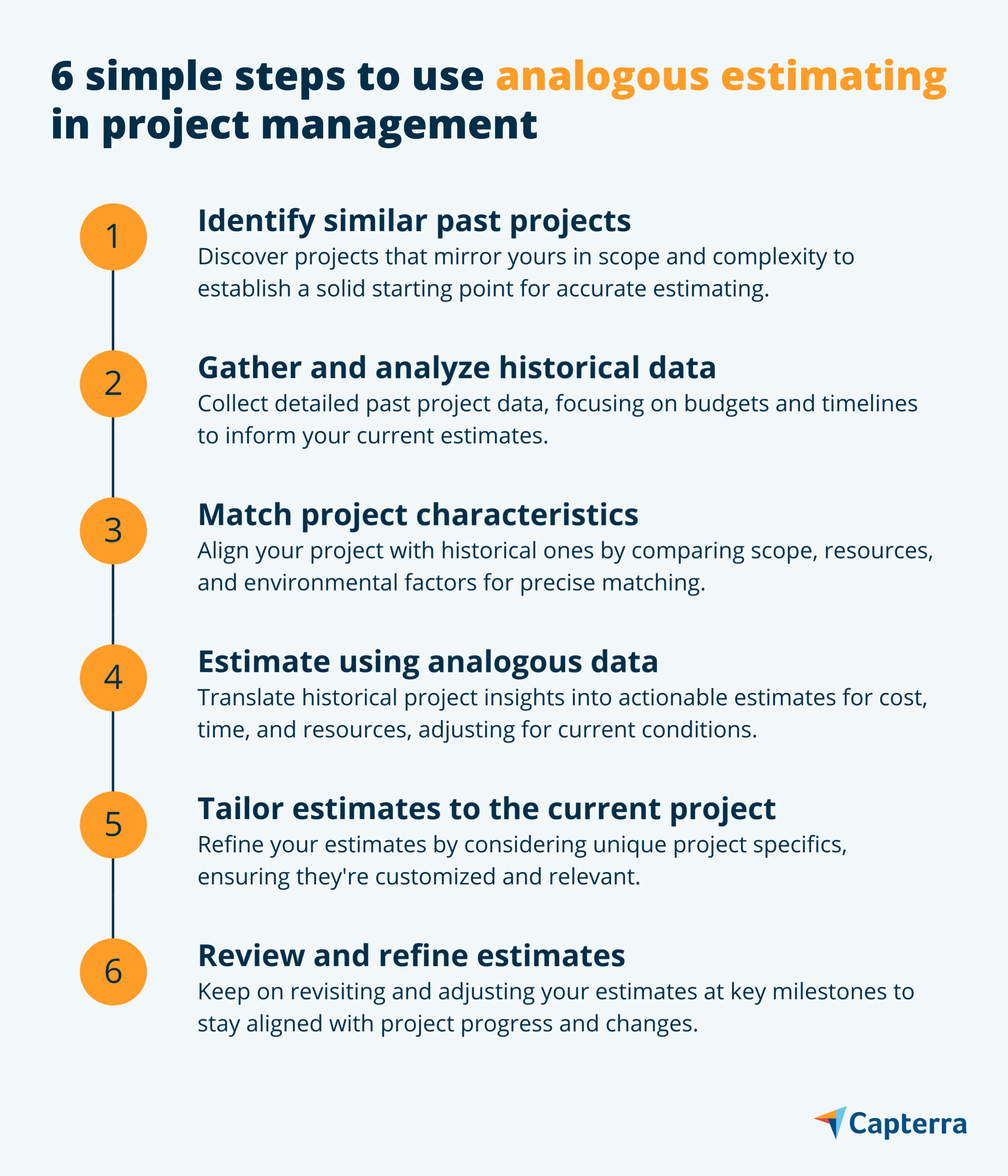Boost project success with accurate budget forecasts using analogous estimating.
Project managers sometimes find themselves navigating the tricky waters of budgeting, juggling tight margins with high expectations. In fact, 54%* of them pinpoint budget management as one of the biggest hurdles they've experienced in the past 12 months. This is especially true in construction and engineering, where the precision in forecasting costs and timelines can make or break a project.
What trips many up? Not knowing the right method for effective budgeting.
The solution? Adopting analogous estimating techniques in project management. This method uses historical data from a similar project to forecast your current project’s budget and timeline. You can make informed estimates by examining past projects, even with limited project details. Learn more about analogous estimation here.
This blog, drawing on insights from experts Peter Koryaka[1] (a project business analyst) and Margarita Kirichenko[2] (a project manager), will guide you through using analogous estimation techniques in your project planning. It aims to boost your confidence and know-how in budgeting so you can keep your projects on course.
"It's like being a detective in a way. When we dig into past projects, it's not just for nostalgia. We're gathering clues. Each old project points us in the right direction for the new ones. It turns our estimates from wild guesses into educated predictions."


Peter Koryaka
Project business analyst at Greenice
"Imagine you're navigating through a city you've visited once before. Analogous estimating is like using those past visits to guide you. We pull from our project history, like using landmarks to avoid traffic jams and find the best routes. It’s about making smart, informed decisions that steer our projects in the right direction from the get-go."


Margarita Kirichenko
Project manager at Greenice
How to use analogous estimating in project management
Project managers strive for fast, accurate project projections and budgeting for project success. Analogous estimation techniques make it happen by using similar past project data. Let's dive into six simple steps you can use to keep your project's budget and timeline on target, making every estimate count.

1. Identify similar past projects
Starting with an analogous estimate means zeroing in on past projects that mirror the one in front of you. Look for projects similar in scope, complexity, size, and even the team's skill level. The goal is to find a match with your estimates' most accurate starting point.
For example, if planning a residential building, choose a previous project with a similar-sized apartment block, budget, and timeline. This comparison offers insights into the expected project cost and timelines.
To effectively identify similar past projects, Koryaka and Kirichenko suggest that you:
Develop a categorized project database by size, budget, and sector.
Consult team members for insights on comparable projects.
Review 'lessons learned' documents for deeper project comparisons.
Adjust historical project cost for current economic conditions for accuracy.
Koryaka emphasizes the importance of data-driven selection. He suggests using a database or project management tool to filter projects by these criteria, ensuring you draw from the most relevant experiences. "It's about finding patterns in the data," Koryaka says, "which projects consistently came in on budget or had similar challenges?"
2. Gather and analyze historical data
Once you've identified similar past projects, the next step is to collect and analyze their historical data. This data includes costs, durations, resources, and challenges encountered. The goal is to build a comprehensive understanding to guide your new project's planning and budgeting.
Consider a previous project like a commercial complex construction. You'd gather data on budget planning versus actual spending, project timelines, workforce allocation, and unplanned expenses or delays.
For a streamlined process of gathering and analyzing historical data, Koryaka and Kirichenko recommend that you:
Include comprehensive data covering financials, timelines, and resource usage.
Identify patterns in spending, timeline adjustments, or resource needs.
Examine projects that exceeded their budgets or timelines to understand why.
Consider each project's unique context, such as economic conditions or technological advancements, which may impact your analysis.
Kirichenko highlights the importance of systematic data collection. "Organize your data to meet your project's specific requirements. Utilize predictive analytics software for clear insights into the cost estimate and timelines, enabling informed decision-making."
3. Match project characteristics
The core of analogous estimating is matching your current project estimation with those from past projects. This involves comparing essential variables like scope, resources, and environmental factors to achieve a close match.
For example, in a web development project, you'd compare the complexity of the application, the programming languages used, the team size, and the delivery timelines. Integrating project planning software here is critical, as it can significantly facilitate this matching process by allowing you to filter and compare past projects based on these variables.
Koryaka and Kirichenko suggest focusing on several areas to achieve an effective match:
Clearly define your current project's scope to identify past projects with similar scopes.
Compare past and present resource types and quantities.
Consider external influences like market trends, regulatory changes, or technological advancements.
Choose past projects that align with your current project's strategic goals and expected outcomes.
Koryaka emphasizes the importance of a detailed comparison of project variables, especially for web development. "Assessing both the technical and functional aspects of past projects is key. For web projects, this includes the technology stack and the project's scale and complexity."
4. Estimate using analogous data
After matching your current project with similar past ones and collecting the relevant data, the next step is to turn this information into practical estimates for costs, timelines, and resources. This process is vital for leveraging your analogies as helpful planning tools.
Imagine that similar past projects typically took six months to complete at a specific cost. You can base your project's timeline and cost estimation on this information. However, adjust for any identified differences in scope, resources, or environmental conditions.
To make accurate estimates using analogous data, Koryaka and Kirichenko suggest you must:
Adjust past project costs to current values to reflect economic changes.
Scale your estimates up or down based on your project's size relative to past projects.
Factor in efficiencies from new technologies that could affect timelines and resource needs.
Include a contingency buffer in your estimates to account for project management uncertainties.
Integrating project tracking software at this stage can significantly improve the accuracy and realism of your estimates.
Kirichenko shares her approach to accurate estimation: "Combining analytical data with practical judgment is key. After analyzing the data, I consider our capabilities and apply a realistic perspective, ensuring our estimates are achievable within the project's constraints."
5. Tailor estimates to the current project
After establishing baseline estimates from analogous past projects, it’s essential to refine these figures to match the unique aspects and requirements of your current project. This step ensures that your estimates are not broad guesses but precisely tailored to your project's specific needs.
For instance, you might need to adjust the estimated budget to include the cost of new software licenses for an IT project or modify the timeline to meet the accelerated schedule of a priority construction project. The goal is to integrate the insights from analogous estimates with an in-depth understanding of your current project's scope and objectives.
To fine-tune your estimates effectively, Koryaka and Kirichenko recommend that you should:
Modify estimates to reflect any project-specific complexities or simplifications.
Leverage stakeholder feedback to ensure estimates align with project expectations and goals.
Update estimates for material costs, labor rates, and other market conditions.
Adjust for efficiencies gained through new technologies or methodologies.
Koryaka emphasizes the need for precision in tailoring estimates for specific technical requirements. "Each project has its unique technical environment. Customizing estimates involves thoroughly examining these specifics. Utilizing requirements management software can streamline this process, ensuring every detail, whether software, hardware, or methodology, is accounted for, making our forecasts as accurate as possible."
6. Review and refine estimates
Estimating is not a one-and-done affair; it's iterative. After creating initial estimates from analogous projects and customizing them for your project's specific needs, it's crucial to keep revisiting and adjusting these numbers. This continuous review is vital for ensuring accuracy and adapting to any changes in project details.
This phase involves checking your estimates at crucial project milestones or when there are significant changes. The aim is to ensure your estimates still match the project's direction, considering any new information or changes in scope, resources, or timelines.
To effectively review and refine your estimates, Koryaka and Kirichenko suggest you must:
Set regular reviews for your estimates, like at project milestones or following crucial decisions.
Gather the latest data on project progress, expenses, and any variations from the original plan.
Consult with your project team to understand if adjustments are needed based on their insights.
Examine performance metrics for trends that could influence future estimates.
Keep evaluating potential risks and uncertainties and update estimates to address these challenges.
Kirichenko speaks to the dynamic nature of project management, "Refining estimates is part of the journey. As we learn more and adapt to changes, our estimates evolve. This flexibility ensures we stay on course, adjusting our sails as needed."
Real-world application of analogous estimating
Koryaka and Kirichenko shared a practical example from their experience at Greenice, showcasing the effective use of analogous estimates in managing complex projects. They highlighted a recent project to revamp an eCommerce platform. To estimate this project, they referred to a similar one completed two years earlier, with a budget of $150,000 and an eight-month timeline.
Koryaka and Kirichenko explained, "We reviewed the previous eCommerce project, examining its scope, challenges, and outcomes. Considering recent technological advances and changes in market conditions, we adjusted our estimates for the new project to $170,000. This adjustment was made to accommodate for inflation and the need for enhanced functionality."
The outcome of this method was impressive. The project was completed with a budget variance within 7% of the initial estimate, demonstrating the accuracy and reliability of analogous estimating. This strategy not only made budgeting and scheduling more efficient but also strengthened the trust of their clients.
Turn this theory into practice to master your budget estimations
To conclude, exploring analogous estimating offers project managers a reliable way to improve their budget and timeline predictions. This method uses insights from previous projects to make forecasting more practical, ensuring decisions are both informed and strategic.
Koryaka and Kirichenko unite in their final thoughts: "Analogous estimating isn't just about looking back—it's about moving forward confidently. By learning from what we've done, we make our next projects smarter, leaner, and more predictable. It's a cycle of improvement that enhances our accuracy and reliability in planning and execution."
Let this guide be your springboard to adopting analogous estimating in your project management practices. With each project, gather data, reflect, and apply your insights, paving the way for more successful, on-target project completions.
